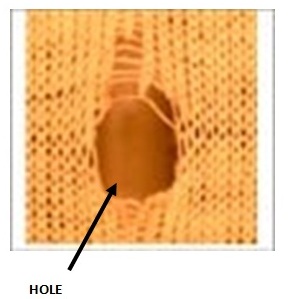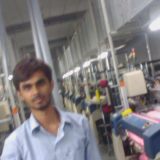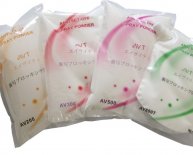
What is Knitted fabric?
A defect of the knitted fabric is an abnormality which spoils the aesthetics i.e. the clean & uniform appearance of the fabric & effects the performance parameters, like; dimensional stability etc.
There are various types of defects which occur in the Knitted fabrics of all types caused by a variety of reasons. The same type of defects may occur in the fabric due to a variety of different causes e.g. Drop Stitches, Spirality etc.
Category of Defects:
Yarn Related Defects:
Almost all the defects appearing in the horizontal direction in the knitted fabric are yarn related. These defects are mainly;
- Barriness
- Thick & Thin lines
- Dark or Light horizontal lines (due to the difference in dye pick up)
- Imperfections
- Contaminations
- Snarling
- Spirality
- Irregular tension on cams.Remedies:
- Replace that bobbin.
- Check cams positioning
Horizontal line in fabric
Broken Needles/ Laddering
Definition:
Defects caused by the broken needles show prominently as vertical lines parallel to the Wales. There are no loops formed in the Wale which has a broken needle.Laddering effects
Causes:- High Yarn Tension
- Bad Setting of the Yarn Feeders
- Old & Worn out Needle set
- Cylinder Grooves are too tight restricting needle movement
- Breakage of hook or butt in needle.
- Ensure uniform & the right Yarn tension on all the feeders.
- Keep the recommended gap between the Yarn Feeders & the Needles.
- Periodically change the complete set of needles.
- Remove fly or blockage from groove.
- Replace defective needle.
Definitions:
Sinker lines are prominent or feeble vertical lines appearing parallel to the Wales along the length of the knitted fabric tube. Causes:
Causes:- Bent or Worn out Sinkers
- Sinkers being tight in the Sinker Ring grooves
- Replace all the worn out or bent sinkers causing Sinker lines in the fabric.
- Sinker lines are very fine & feeble vertical lines appearing in the fabric.
- Remove the fibers clogging the Sinker tricks (Groove
Definitions:
Oil lines are prominent vertical lines which appear along the length of the knitted fabric tube. The lines become permanent if the needle oil used is not washable & gets baked due to the heat during the finishing of the fabric.Causes:
- Fibers & fluff accumulated in the needle tricks which remain soaked with oil.
- Excessive oiling of the needle beds.
- Fibers accumulated in the needle tricks cause the oil to seep into the Fabric.
- Some lubricating oils are not washable & can not be removed during Scouring.
- Remove all the Needles & the Sinkers of the machine periodically.
- Clean the grooves of the Cylinder & Dial of the machine thoroughly with petrol.
- Blow the grooves of the Cylinder Dial & Sinker ring with dry air after cleaning.
Definition:
Broken ends appear as equidistant prominent horizontal lines along the width of the fabric tube when a yarn breaks or is exhausted. Causes:
Causes:- Yarn exhausted on the Cones.
- Ensure correct yarn tension on all the feeders.
- Ensure that the Yarn detectors on all the feeders are working properly.
- Depute a skilled & alert machine operator on the knitting machine.
Definition:
Fabric press off appears as a big or small hole in the fabric caused due to the interruption of the loop forming process as a result of the yarn breakage or closed needle hooks.Press off takes place, when the yarn feeding to both the short butt & long butt needles suddenly stops due to the yarn breakage.
At times complete fabric tube can fall off the needles if the needle detectors are not functioning or are not properly set.
- End breakage on feeders with all needles knitting.
- Yarn feeder remaining in lifted up position due to which the yarn doesn’t get fed in the hooks of the needles.
- Needle detectors, should be set precisely to detect the closed needles & prevent the fabric tube from completely pressing off.
- Proper yarn tension should be maintained on all the feeders.
Definition:
Surface hairiness appears in the form of excess superfluous fibers, on the surface of the knitted fabrics, which have either been reprocessed, or tumble dried.Pilling appears as, small fiber balls formed on the fabric surface, due to the entanglement of loose surface fibers.
Factors such as, the fiber staple length, low T.P.M. & fabric construction (with long yarn floats) etc. also contribute to pilling.
- Abrasion due to the contact with rough surfaces
- Excessive surface hairiness caused, due to the abrasive tumbling action
- Fabric friction in the Tumble Dryer
- Rough Dyeing process & abrasive machine surfaces (Soft Flow Machine tubes, Tumble Dryer drum etc.)
- Reprocessing of the fabric is, also a major cause of piling.
- Avoid using the Tumble Dryer.
- Control shrinkage by maximum fabric relaxation & over feed in the processing.
- Regularly inspect the fabric contact points on all the machines, for any rough & sharp surface.
- Avoid repeated reprocessing of the fabrics.
- Use anti pilling chemical treatments for the fabrics prone to pilling.
Definition:
Snagging appears on the knitted fabric surface as a pulled up yarn float showing up in the form of a large loop.- Caused by the pulling or the plucking of yarn from the, fabric surface, by sharp objects.
- Inspect & rectify the fabric contact points on all the machines (Soft Flow Dyeing, Tumble Dryer & Centrifuge etc), on which snagging is taking place.
Definition:
Bowing appears as rows of courses or yarn dyed stripes forming a bow shape along the fabric width.- Uneven distribution of tensions across the fabric width while dyeing or finishing...
















